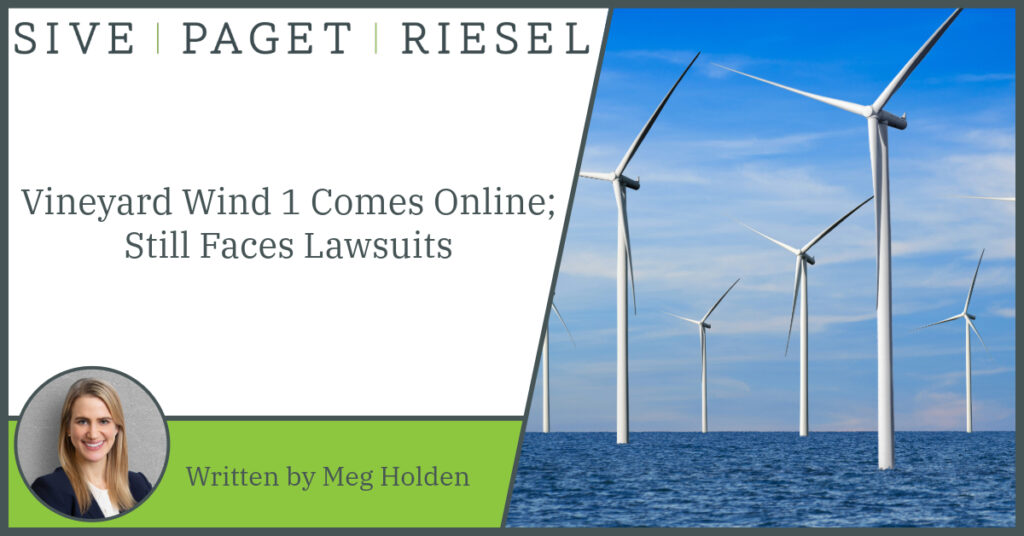Blog

Vineyard Wind 1 Comes Online; Still Faces Lawsuits
On January 2, 2024, the Vineyard Wind 1 project started producing power for the United States grid, becoming the second commercial-scale offshore wind project to do so after South Fork Wind came online in December 2023. This significant milestone comes as the U.S. Court of Appeals for the First Circuit considers appeals in several lawsuits brought against the Vineyard project.
Vineyard Wind 1, which is located approximately 15 miles southeast of Martha’s Vineyard and Nantucket, began operating one wind turbine earlier this month, but developers are installing an additional 61 turbines, for a total capacity of 800 megawatts. When fully operational, the facility is expected to supply enough renewable energy to power 400,000 homes.
While developers work to bring Vineyard Wind 1 up to capacity, the project remains the subject of several lawsuits. Most recently, on January 3, the federal government filed its response brief in Melone v. Coit, Case No. 23-1736, asking the First Circuit to uphold the trial court’s ruling that the National Marine Fisheries Service’s (NMFS) issuance of an Incidental Harassment Authorization (IHA) allowing for the non-lethal incidental take of up to 20 North Atlantic right whales was not arbitrary or capricious. The plaintiff, a part-time resident of Martha’s Vineyard and solar-farm developer, challenged NMFS’s issuance of the IHA, alleging that it violated the Marine Mammals Protection Act (MMPA).
The MMPA permits “the incidental, but not intentional, taking by harassment of small numbers of marine mammals of a species of population stock” if NMFS “finds that such harassment during each period concerned will have a negligible impact on such species or stock.” 16 U.S.C. § 1371(a)(5)(D)(i)(I). The MMPA does not define “small numbers;” rather, NMFS makes this determination based on whether the number of individuals taken annually from a specified activity is small relative to the population size. NMFS has stated that it considers one-third of a species’ population to be the upper limit of “small numbers.” In September 2018, Vineyard Wind requested that NMFS issue an IHA allowing it to “take,” by harassment, a small number of marine mammals incidental to project construction. NMFS determined that the noise from pile-driving could impact up to 20 North Atlantic right whales (about 5.4% of the population), concluded that the project construction would therefore have a negligible impact on marine species, and granted the IHA.
The plaintiff argued that it was arbitrary for NMFS to determine that the project would only impact small numbers of North Atlantic right whales, challenging NMFS’s policy that one-third of a population is “small.” The District Court ruled in favor of NFMS, finding that the plaintiff failed to show that NMFS acted arbitrarily, capriciously, or otherwise unlawfully in issuing the IHA, and holding that the agency’s interpretation of the “small numbers” language within the MMPA was entitled to Chevron deference. The plaintiff appealed the District Court’s ruling to the First Circuit. The government submitted its response brief to the First Circuit on January 3, and on January 10, Vineyard Wind filed a brief defending its intervention and supporting the federal government’s arguments that the IHA complied with the MMPA.
Two other lawsuits related to the Vineyard Wind 1 project are also pending in the First Circuit. ACK Residents Against Turbines v. US Bureau of Ocean Energy Management et al., Case No. 23-01501, was brought by Nantucket residents and similarly focuses on impacts to the North Atlantic right whale. However, rather than bringing claims related to the MMPA, the Nantucket plaintiffs challenge the environmental review of the project and claim that the defendants violated requirements of the Endangered Species Act. The other pending case, RODA et al., v. U.S. Dep’t of the Interior, et al., Case No. 23-02051, was initiated by commercial fishing interests and challenges the federal permits obtained by Vineyard Wind 1. In both cases, the District of Massachusetts had granted summary judgment in favor of the federal government and wind developer.
Vineyard Wind 1 is among several commercial-scale offshore wind projects in development in the United States. As noted, South Fork Wind was the first commercial-scale offshore wind project to come online, commencing operations in December 2023. Like Vineyard, South Fork has also faced litigation challenges, although none are currently pending. Several other projects, including Equinor’s Empire Wind and Beacon projects, are also currently under development.